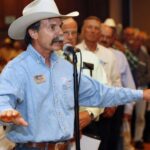If ever there was a good idea gone bad, it is the National Animal Identification System.
In fact, if you were to write a textbook on how to turn people against something, it would be titled “NAIS: Fear and Loathing in the Countryside.”
All along, small producers expressed their dismay at a system that would make them register their premises no matter whether they had a single goat or a herd of 1,000. That they were required to report any movement of their animals added to the sense of “big brother” watching them.
It is a statement of the obvious that folks who make their living on farms and ranches are independent-minded and have a healthy distrust of big government. The idea that the government was collecting a file full of information about every farm or ranch with one or more animals seemed even more menacing.
When the USDA tried to force 4-H and FFA members into registering their premises before they could show their animals at fairs, more red flags were hoisted.
A program presented as voluntary that would phase in over years suddenly looked as though it would be imposed whether anyone wanted it or not.
Indeed, after five years, only 36 percent of premises have been registered under NAIS. That an estimated 768,000 farmers and ranchers chose not to sign up under NAIS is testimony in itself about what they think about it.
The irony is that the concept behind NAIS is a good one. A further irony is that pork producers and dairy operators have had a variation of it for years, and many states have brand inspection programs that nearly duplicate what NAIS would accomplish. Larger operators of all types maintain scrupulous records on their animals.
When a disease appears in a population of animals, the state and federal governments must move quickly and decisively. Every minute lost chasing records could mean the spread of the disease will continue exponentially.
There’s no doubt about it. NAIS is one way – but not the only way – to allow officials to identify and isolate afflicted populations.
There aren’t many pork producers or dairy operators who couldn’t tell you everything you’d every want to know about any of their animals. For them, it’s part of their business. Even so, the first case of bovine spongiform encephalopathy in Washington state demonstrated how long it can take to trace where the animal came from – Canada – and where its herd mates may have gone. Ultimately, some of those questions were not definitively answered after months of investigation.
That experience alone points to the need for a better system. Unfortunately, as it now stands, NAIS may not fit that bill.
At a hearing last week in Pasco, Wash., all but two of the 75 producers who testified opposed NAIS. These were not wild-eyed conspiracy theorists with tin foil on their heads. They included the state veterinarian, two statewide cattle organizations and other operators, large and small.
“Washington state has a good existing system, and the USDA needs to take the opportunity to slow down and see what the states are doing for a traceability system,” said Jack Field, executive director of the Washington Cattlemen’s Association.
Washington State Veterinarian Leonard Eldridge urged the USDA to “remain voluntary and flexible.” The state currently has tracking systems for cattle brands – as do other states – and for brucellosis. Sheep are tagged under a scrapies prevention program.
With those programs in force, it’s clear the added benefit NAIS offers to cattle and sheep producers would be minimal.
USDA Secretary Tom Vilsack is wise to call a time-out and listen closely to producers before going ahead with full implementation of NAIS. They have a lot to say, and it’s all worth hearing.
Ultimately, the answer will lie in an NAIS program that dovetails with the states’ efforts – and respects the rights of all producers, large and small.
Original Article Here: http://capitalpress.com/main.asp?SectionID=75&SubSectionID=767&ArticleID=51600



